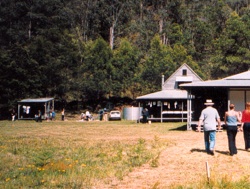Sustainable and green
Sustainability – an impossibility?
Among the many definitions of sustainable The Worldwatch Institute http://www.worldwatch.org/ defines it as "meeting present needs without compromising the ability of future generations to meet their own needs." For example, wood harvested from a "sustainable forest" means that the wood is derived from a forest managed in a manner so that the trees harvested will be replaced at a rate that matches the rate of removal. In this regard, the forest will continue producing wood for successive generations.
To embrace the true meaning of sustainability is not possible without a massive change in our levels of consumption, the way we make things and the way we live. The urgent need to make these changes is underscored by the fact that the world supplies of oil are running out more quickly than anticipated and the levels of global warming are increasing more quickly than previously thought.
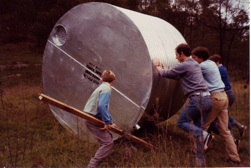
We can do something
Despite the hugeness of the task we can start to do things individually to help to turn things around. A lot of these actions relate to the profligacy of our consumptive behaviour across many fields and that
includes what we do in our houses.
Many sustainable practices in the home represent a return to simpler, less energy consuming ways of doing
things, which were common practice fifty years ago, such as:
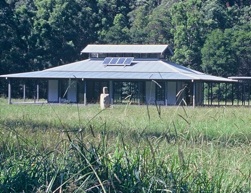
Natural ventilation instead of air conditioning
Natural lighting instead of artificial
Recycling rainwater by collecting it in tanks
The adaptive re-use of existing housing
Having smaller rooms to heat and cool.
There are a number of websites that give really good tips on what we can do, which include: Your Home http://www.yourhome.gov.au/
and ACF’s Green Home website,
BASIX
In NSW, all new housing and alterations and additions of a value above $50,000 now have to comply with BASIX. BASIX is an on-line web tool, which sets standards for various building components in order to achieve reductions in energy and water use in order to reduce green house gas emissions, including:
Light fixtures
Shower heads, toilets and taps, solar hot water systems
Solar power systems, wall and ceiling insulation levels
U levels for glazing and skylights
Shading devices for windows
Rain water collection
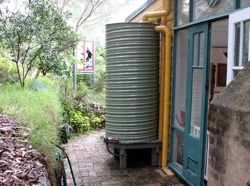
Experience with green technology
I have have been involved in green building practice since the 1970s. When I first became involved with the house at Killcare (see 30 Grandview Crescent Killcare), the only connection to any main service supply was electricity.
Water was collected in two large tanks from the roof and pumped to a holding tank, which gravity fed the shower and kitchen sink. For the first few years we still had the dunny man, who arrived in the dark of the early morning, a torch strapped to his belt, to pick up the full pan from the outside dunny and replace it with an empty one.

We were one of the first to experiment with an internal electric-powered composting toilet. The Ecolette, which was imported from Sweden, was supposed to evaporate liquid waste and reduce solid waste to a dry crust which could be scraped off from underneath into a tray and could then be used in the garden – it didn’t work for us.
Eventually the sewer and town water came through. The tanks and rainwater pumps were demolished (as required by Council) in the late 1980s – this is in an area that continues

The latest response to the water problem is the toilet on the left, which was installed in early 2009 and has its basin above the cistern so that the hand washing water is used to flush the toilet bowl.
The Zen Buddhist Retreat Centre (see Kodoji – a Zen Temple) is completely off-grid as is the Braidwood cottage (see Braidwood House in Country Cottages).
There are several green aspects to the Terrace House in Paddington (in Recent Projects).
We have recently installed a number of green features at our place (see A house by a river). We installed a rainwater tank and pump for garden use, an Atticus evaporated tube solar hot water system and a 1Kw grid connect solar system. So far we have achieved a 40% reduction in our annual electricity use
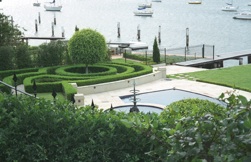
One of the major green elements in any house is the garden. These days, the number of entirely inappropriate landscape designs is increasing. Highly manicured formal gardens are bereft of trees and their clipped hedges, trimmed lawns and topiary proclaim that the owners can afford to have paid help to come every few days to keep it neat and tidy. These formal gardens also require enormous quantities of water to prevent their alien species and lawns from giving up the ghost.
At left- a high maintenance and water guzzling garden

How much better is a garden of native grasses, shrubs and trees, which is low maintenance, low water use, supports biodiversity and gives a sense of continuity to the neighbourhood by reference to its native bush.
The photo on the left of the garden at the house by a river shows the native grass lawn, which needs no mowing and low water using trees etc. The vegie garden has the possum protecting mesh removed from its hoops in preparation for planting the latest crop.
Some of these options are not necessarily suitable or appropriate for the average home-owner. Unless you are a recycling enthusiast, black water recycling is probably something that is best confined to places where the sewer is not available. Similarly, grey water recycling may not be necessary if you have installed sufficient capacity in your rain water collection tanks.
Our 1000 litre water tank, for instance, has been totally full since it was installed in February 2007, so that any grey water we may have recycled would have been entirely superfluous to our needs.
You can purchase “green power” as a voluntary extra. It seems a little like how the Government relies on charities to fund welfare for those in need instead of taking decisive action. If you have forked out the extra dollars to install grid-connect solar panels, then you have already invested substantially in “green power”.
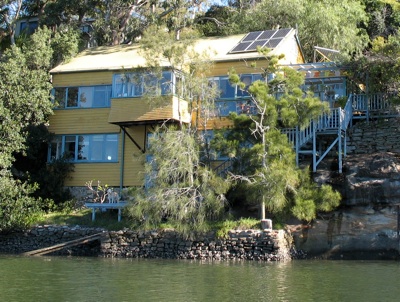
A house by a river
A wide shot showing the photo voltaic panels and the Atticus evaporated tube solar hot water system. David Wilshire installed the power system and Ashmore Plumbing installed the hot water system.
